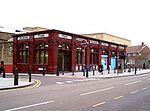Kilburn High Road railway station
1851 establishments in EnglandDfT Category E stationsFormer London and North Western Railway stationsKilburn, LondonLondon stations without latest usage statistics 1415 ... and 7 more
London stations without latest usage statistics 1516London stations without latest usage statistics 1617Rail transport stations in London fare zone 2Railway stations in Great Britain opened in 1852Railway stations in the London Borough of CamdenRailway stations served by London OvergroundUse British English from August 2012

Kilburn High Road railway station is a London Overground station on the London Euston to Watford DC Line near the south end of the Kilburn High Road, London NW6 in the London Borough of Camden.
Excerpt from the Wikipedia article Kilburn High Road railway station (License: CC BY-SA 3.0, Authors, Images).Kilburn High Road railway station
Belsize Road, London South Hampstead (London Borough of Camden)
Geographical coordinates (GPS) Address Nearby Places Show on map
Geographical coordinates (GPS)
| Latitude | Longitude |
|---|---|
| N 51.5374 ° | E -0.1919 ° |
Address
Kilburn High Road
Belsize Road
NW6 4AA London, South Hampstead (London Borough of Camden)
England, United Kingdom
Open on Google Maps








